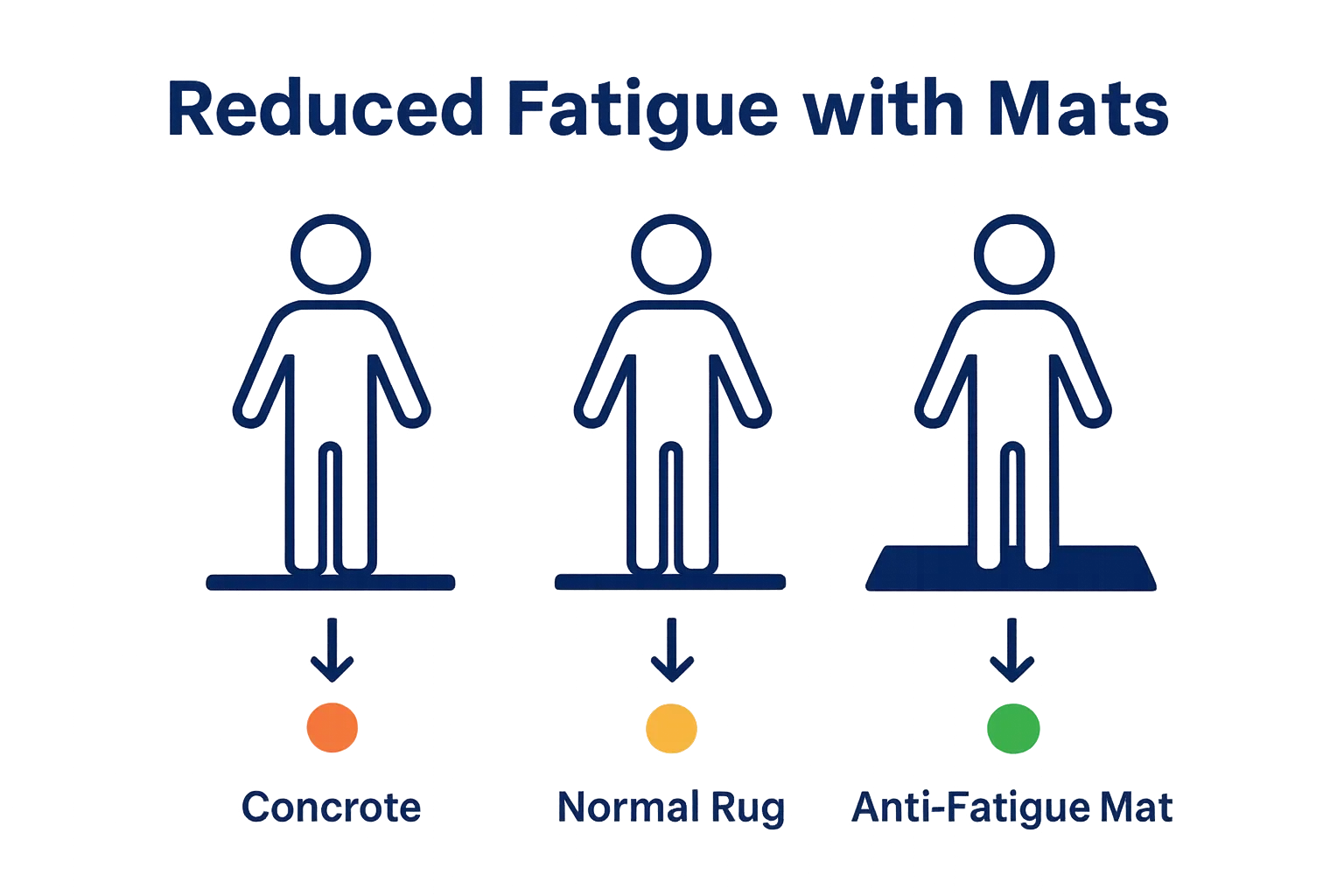Standing on hard floors for hours might seem harmless, yet it quietly chips away at comfort and health. Surprising as it sounds, up to 38 percent of workers who stand all day report chronic lower back pain and fatigue. Most people think thick socks or a quick stretch are enough, but modern anti fatigue mats use smart design and material science to turn the ordinary floor into a hidden source of relief.
Table of Contents
- What Are Anti Fatigue Mats?
- Why Do Anti Fatigue Mats Matter In The Workplace?
- How Do Anti Fatigue Mats Work To Reduce Fatigue?
- Key Features And Materials Of Anti Fatigue Mats
- Real-World Applications And Benefits In Different Settings
Quick Summary
| Takeaway | Explanation |
|---|---|
| Anti fatigue mats reduce worker fatigue. | These mats are designed to minimize physical stress for individuals standing for long periods, promoting comfort and productivity. |
| Mats encourage subtle muscle engagement. | The unique design prompts continuous micro-movements, which stimulate circulation and reduce muscle tension during standing. |
| Economic benefits for businesses exist. | Implementing these mats can lower absenteeism rates and compensation claims, providing a return on investment for employers. |
| Proper material composition is crucial. | High-density foam, rubber, and advanced polymers enhance shock absorption and support, allowing mats to effectively reduce strain. |
| Various industries benefit from mats. | From hospitals to retail, different sectors utilize these mats to improve employee comfort and reduce health risks associated with prolonged standing. |
What Are Anti Fatigue Mats?
Anti fatigue mats are specialized floor coverings engineered to reduce physical stress and discomfort for workers who stand for extended periods. Occupational safety experts recognize these mats as crucial ergonomic interventions designed to minimize strain on the human body during prolonged standing.
The Science Behind Anti Fatigue Comfort
At their core, anti fatigue mats work by creating subtle micro-movements that encourage muscles to contract and expand. When standing on a hard surface like concrete or tile, human muscles remain statically contracted, which restricts blood flow and leads to fatigue. These specialized mats introduce slight instability, prompting continuous minor adjustments that stimulate circulation and reduce muscular tension.
The mat’s construction typically involves multiple layers of specialized materials like high-density foam, rubber, or advanced polymer composites. These materials are strategically engineered to provide:
- Shock absorption to reduce joint impact
- Cushioning to distribute body weight evenly
- Resilient support that promotes subtle muscle engagement
Workplace and Industrial Applications
Anti fatigue mats serve critical roles across numerous professional environments. From industrial manufacturing floors to retail checkout areas, workplace ergonomics research demonstrates their significant potential in reducing worker fatigue and potential musculoskeletal disorders. Workers in sectors like healthcare, food service, assembly lines, and professional kitchens can substantially benefit from these innovative floor solutions.
By addressing the physiological challenges of prolonged standing, read more about workplace ergonomic solutions, these mats represent a proactive approach to employee health and workplace comfort.
Why Do Anti Fatigue Mats Matter in the Workplace?
Workplace ergonomics play a critical role in employee health and productivity, with anti fatigue mats emerging as a key intervention for reducing physical strain. Occupational health studies demonstrate that prolonged standing can lead to significant health risks and decreased worker performance.
Health and Productivity Implications
The impact of standing for extended periods extends far beyond immediate discomfort. Workers exposed to long hours of static standing face numerous health challenges, including:
- Increased risk of musculoskeletal disorders
- Reduced blood circulation in lower extremities
- Higher likelihood of chronic lower back pain
- Potential cardiovascular stress
Anti fatigue mats serve as a critical ergonomic solution by mitigating these potential health risks. By encouraging subtle muscle movements and providing cushioned support, these mats help reduce the physiological stress associated with prolonged standing.
Economic Benefits for Employers
Beyond individual health considerations, anti fatigue mats represent a strategic investment for businesses. Workplace safety research indicates that ergonomic interventions can significantly reduce worker compensation claims and productivity losses. Companies implementing these mats often observe:
- Decreased worker fatigue and increased energy levels
- Reduced absenteeism related to musculoskeletal issues
- Improved overall workplace morale and job satisfaction
Learn more about specialized anti fatigue solutions for different workplace environments, which demonstrate how targeted ergonomic strategies can transform workplace wellness and productivity.
How Do Anti Fatigue Mats Work to Reduce Fatigue?
The mechanism behind anti fatigue mats involves sophisticated biomechanical principles designed to counteract the negative physiological effects of prolonged standing. Ergonomic research reveals the intricate ways these specialized floor coverings interact with human body mechanics to reduce physical strain.
Biomechanical Movement and Circulation
Anti fatigue mats function through a principle of subtle instability, which triggers continuous microscopic muscle adjustments. When standing on these mats, workers unconsciously make tiny postural corrections, which stimulate blood flow and prevent muscle stagnation. This perpetual movement prevents blood from pooling in lower extremities and reduces the static load on joints and muscles.
The mat’s unique design creates a dynamic surface that encourages:

- Gentle muscle engagement
- Improved proprioceptive responses
- Reduced joint compression
- Enhanced metabolic activity in lower body muscles
Material Science and Ergonomic Design
Advanced anti fatigue mats incorporate complex material technologies that go beyond simple cushioning. Specialized polymers and engineered composites provide strategic support, distributing body weight and absorbing shock with precision. Biomechanical studies demonstrate that these materials can significantly reduce the cumulative stress on worker’s musculoskeletal systems.
The structural composition typically includes multiple density zones and responsive materials that adapt to individual worker movements. Learn more about specialized rubber mat technologies that optimize workplace ergonomic solutions and worker comfort.
Key Features and Materials of Anti Fatigue Mats
Industrial ergonomics research reveals that the effectiveness of anti fatigue mats depends significantly on their material composition and design characteristics. Understanding these key features helps organizations select the most appropriate solutions for their specific workplace environments.
Material Composition and Performance
Anti fatigue mats are crafted from diverse materials, each offering unique performance characteristics. Specialized polymers and synthetic compounds enable manufacturers to create mats with targeted ergonomic properties. The primary materials include:
- Natural rubber with high resilience
- Closed cell foam for superior shock absorption
- Vinyl composites with enhanced durability
- Advanced polymer blends with responsive cushioning
- Nitrile rubber for chemical resistance
Each material brings distinct advantages, allowing organizations to choose mats tailored to specific industrial requirements such as temperature tolerance, chemical exposure, or moisture resistance.
The following table summarizes the primary materials used in anti fatigue mats and highlights their key performance characteristics, helping employers select the best option for specific workplace needs.
| Material Type | Key Benefits | Typical Usage Scenarios |
|---|---|---|
| Natural Rubber | High resilience, durable, slip-resistant | Industrial floors, wet environments |
| Closed Cell Foam | Superior shock absorption, lightweight | Offices, dry workstations |
| Vinyl Composite | Enhanced durability, moisture-resistant | Healthcare, food service, retail areas |
| Advanced Polymers | Responsive cushioning, adapts to movement | Ergonomic office, assembly lines |
| Nitrile Rubber | Chemical-resistant, withstands oils | Industrial kitchens, chemical plants |
Critical Design Features
Beyond material selection, anti fatigue mats incorporate sophisticated design elements that enhance their functional performance. Ergonomic engineering focuses on creating surfaces that promote micro-movements and reduce static muscle strain.
Key design considerations include:
- Textured surface patterns for improved traction
- Beveled edges to prevent tripping hazards
- Variable density zones for targeted support
- Moisture and slip resistance capabilities
Explore specialized anti fatigue mat technologies that demonstrate how advanced material science transforms workplace comfort and safety.
Real-World Applications and Benefits in Different Settings
Healthcare workplace research demonstrates that anti fatigue mats provide critical ergonomic solutions across diverse professional environments. Their adaptability makes them essential for managing physical strain in multiple workplace scenarios.
Industrial and Manufacturing Environments
In high-demand manufacturing settings, workers frequently stand on hard surfaces for extended periods, experiencing significant physical stress. Anti fatigue mats become crucial ergonomic interventions that mitigate potential musculoskeletal disorders. These mats offer substantial benefits in:
- Assembly line workstations
- Quality control zones
- Packaging and shipping areas
- Machine operation platforms
- Welding and fabrication spaces
The strategic placement of these mats can reduce worker fatigue, potentially decreasing workplace injuries and improving overall productivity.
Service and Retail Sector Applications
Service industry professionals like retail associates, cashiers, chefs, and baristas experience prolonged standing as an occupational requirement. Anti fatigue mats provide critical support in:
- Checkout counters
- Commercial kitchen environments
- Salon and spa workstations
- Retail display areas
- Food service preparation zones
By minimizing physical strain, these mats contribute to enhanced worker comfort and potentially reduced workplace compensation claims.
The following table provides an at-a-glance comparison of how anti fatigue mats benefit different workplace settings, outlining specific advantages and target work areas for each sector.
| Sector | Key Advantages | Common Mat Placement Areas |
|---|---|---|
| Industrial/Manufacturing | Reduces injury risk, improves stamina | Assembly lines, machine stations, shipping |
| Healthcare | Minimizes back pain, boosts mobility | Nursing stations, operating rooms, pharmacies |
| Retail | Increases comfort, lowers fatigue | Checkout counters, display areas |
| Food Service/Restaurants | Improves safety, supports long shifts | Kitchens, food prep zones, bar stations |
| Service (Salons/Spas) | Eases prolonged standing, reduces strain | Stylist stations, reception desks |

Explore specialized anti fatigue solutions for different workplace environments that demonstrate targeted ergonomic strategies for various professional settings.
Discover the True Value of Anti Fatigue Mats for Your Workplace
After learning how anti fatigue mats help prevent fatigue, improve circulation, and reduce long-term pain, it is clear that the right mat can transform your employees’ workday. If you want to protect your team from discomfort and boost their productivity, you need ergonomic solutions designed for real workplace challenges. Many businesses struggle with recurring worker fatigue, frequent breaks, and higher rates of injury due to overlooked flooring issues. The solution starts with quality materials and thoughtful design, just like you explored in the article.
Take control of workplace comfort today by exploring our premium options in the Anti-Fatigue Mats Collection, all built for commercial durability and effectiveness. Ready to begin? Visit Mats4U.com to find the best fit for your environment, or browse our Comfort Range for additional ergonomic choices. Make the switch and experience the difference that expert-approved anti fatigue mats can create for your team right now.
Frequently Asked Questions
What are anti fatigue mats?
Anti fatigue mats are specialized floor coverings designed to reduce physical stress and discomfort for workers who stand for long periods. They promote better blood circulation and decrease fatigue.
How do anti fatigue mats work to reduce fatigue?
Anti fatigue mats encourage subtle muscle movements through slight instability, preventing blood from pooling and reducing static load on joints and muscles, which helps mitigate fatigue associated with prolonged standing.
What materials are commonly used in anti fatigue mats?
Anti fatigue mats are made from various materials, including natural rubber, closed cell foam, vinyl composites, and advanced polymers, each offering unique benefits such as shock absorption, durability, and chemical resistance.
What are the benefits of using anti fatigue mats in the workplace?
The benefits of anti fatigue mats include reduced risk of musculoskeletal disorders, improved worker productivity, decreased absenteeism, enhanced energy levels, and overall better workplace morale.







